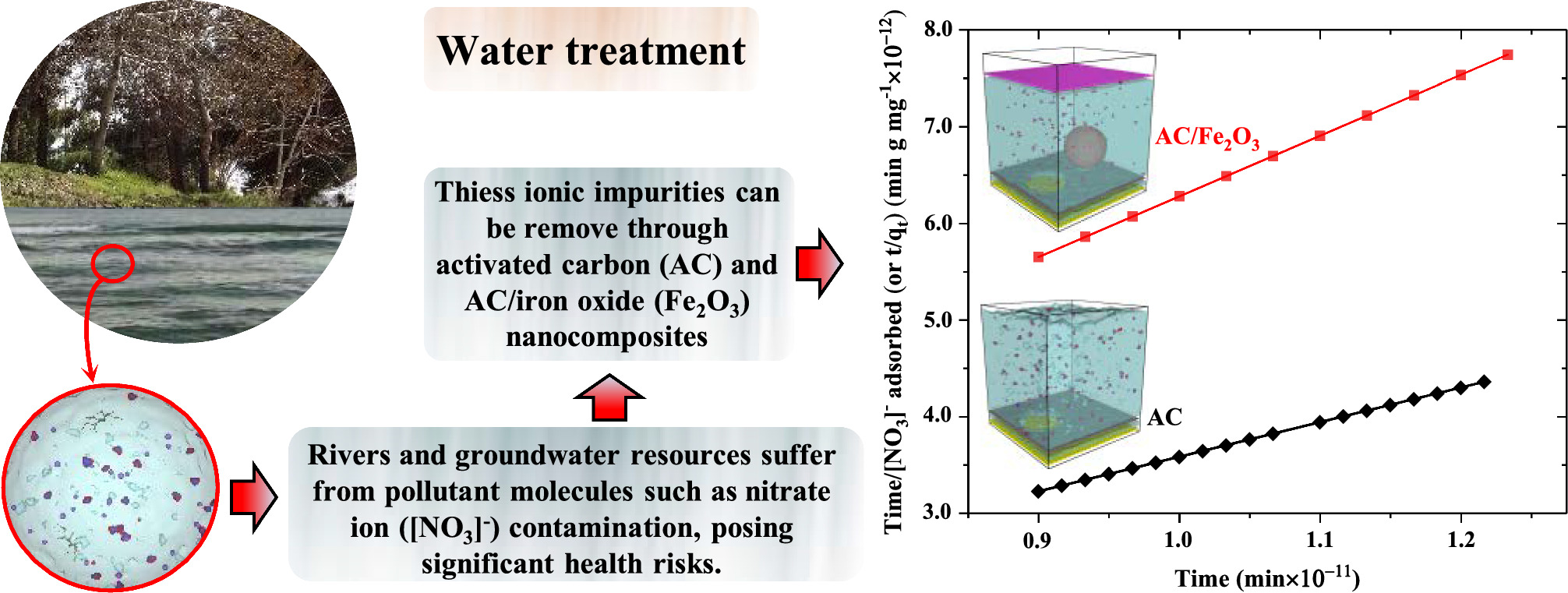https://doi.org/10.1140/epjp/s13360-025-06433-7
Regular Article
Molecular dynamics study of nitrate adsorption from aqueous solutions using activated carbon modified with Fe2O3 nanoparticles: The impact of Fe2O3 nanoparticles
1
Department of Chemical Engineering, Yasouj University, 75918-74934, Yasouj, Iran
2
Department of Physics and Energy Engineering, Amirkabir University of Technology, 159163-4311, Tehran, Iran
3
Institute of Sustainable and Autonomous Maritime Systems, University of Duisburg-Essen, 47057, Duisburg, Germany
a Hakimeh.sharifi@gmail.com, h.sharififard@yu.ac.ir
b
bonyadi@yu.ac.ir
Received:
28
December
2024
Accepted:
13
May
2025
Published online:
4
June
2025
Groundwater resources, especially in rural areas, suffer from nitrate ion ([NO3]−) contamination, posing significant health risks. This research examines the influence of iron(III) oxide (Fe2O3) nanoparticles on the adsorption mechanisms and kinetics of adsorbed [NO3]− from a 0.118 M sodium nitrate solution by activated carbon (AC) and AC/Fe2O3 nanocomposites to develop simulation guidelines that align with experimental data using molecular dynamics simulations. For AC, the results reveal that sodium ion (Na+) and [NO3]− were adsorbed by 8.22% and 6.85%, respectively, due to the concentration gradient between the solution and the adsorbent. This approximately balanced adsorption originates from the principle of local conservation of electrostatic charge distribution, which limit the effectiveness of [NO3]− removal. In AC/Fe2O3 nanocomposite, adsorption occurs due to both the concentration gradient and the Coulombic forces of the Fe2O3 nanoparticle. The nanoparticle mitigates the effects of the local electrostatic charge conservation principle, leading to a 2.5-fold increase in the adsorption of [NO3]− compared to Na+. A comparison of the amount of [NO3]− adsorbed at equilibrium reveals values of 2.7905 mg g−1 for the AC/Fe2O3 and 1.5926 mg g−1 for AC, indicating that Fe2O3 enhances the [NO3]− removal process. The agreement between computational and experimental data underscores the algorithm's capability to capture nanosecond-scale temporal and spatial attributes that are difficult to investigate experimentally.
Supplementary Information The online version contains supplementary material available at https://doi.org/10.1140/epjp/s13360-025-06433-7.
Copyright comment Springer Nature or its licensor (e.g. a society or other partner) holds exclusive rights to this article under a publishing agreement with the author(s) or other rightsholder(s); author self-archiving of the accepted manuscript version of this article is solely governed by the terms of such publishing agreement and applicable law.
© The Author(s), under exclusive licence to Società Italiana di Fisica and Springer-Verlag GmbH Germany, part of Springer Nature 2025
Springer Nature or its licensor (e.g. a society or other partner) holds exclusive rights to this article under a publishing agreement with the author(s) or other rightsholder(s); author self-archiving of the accepted manuscript version of this article is solely governed by the terms of such publishing agreement and applicable law.





